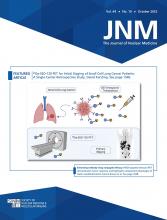Fibroblast activation protein (FAP)–targeted PET imaging is promising for cancers with a high content of cancer-associated fibroblasts (1,2). However, FAP is also expressed by activated fibroblasts involved in multiple fibroinflammatory nononcologic conditions. FAP is involved in remodeling processes by stimulating fibrosis and extracellular matrix remodeling after an infarction. After myocardial infarction, FAP inhibitor (FAPI) PET imaging can show the activated fibroblasts (3) in the territory of the occluded coronary artery (4). In the early stage of renal fibrosis, fibroblasts accumulate in the renal parenchyma. Preliminary experience with FAPI PET quantification of renal fibrosis has been reported (5).
Here, we report the case of an 83-y-old man with clear cell renal cell carcinoma of the left kidney with gross hematuria requiring blood transfusions and an emergency embolization of the left renal artery (Fig. 1). Subsequently nephrectomy was planned, and the patient preoperatively underwent both [18F]FDG (26 d after embolization) and [68Ga]Ga-FAPI-46 PET/CT (67 d after embolization) as part of the exploratory study (NCT04147494), which was approved by the institutional review board. The primary tumor had a slight hypermetabolism at its periphery ([18F]FDG SUVmax, 5.9) without increased FAP uptake (FAPI SUVmax, 2.0). [68Ga]Ga-FAPI-46 PET/CT showed increased uptake in the embolization area in the lower-pole left kidney parenchyma (SUVmax, 4.1 vs. 1.7 in the normal parenchyma). [18F]FDG PET/CT showed significantly decreased uptake at the infarction site (SUVmax, 1.9 vs. 4.8 in the normal parenchyma). The FAP immunohistochemistry staining performed on the nephrectomy tissue showed an increased FAP expression in the ischemic areas that included reactive fibroblasts, whereas the primary tumor had no significant FAP expression. The corresponding hematoxylin and eosin staining showed the ischemic stromal cells and adjacent tumor. Our findings suggest that [68Ga]Ga-FAPI-46 PET/CT molecular imaging can show FAP expression in fibrotic renal tissue and may represent a valuable biomarker for remodeling processes after infarction of the kidney.
(Row 1) Preembolization angiography with contrast extravasation of lower branch of left renal artery and tumor-associated neovasculature (left panel, circle) and postembolization angiography showing occlusion of arterial vessels (right panel, circle). (Rows 2 and 3, from left to right) Maximum-intensity-projection, CT, PET, and PET/CT images obtained with [68Ga]Ga-FAPI-46 and [18F]FDG. Blue arrows denote primary tumor, and red arrows denote embolization area. (Row 4) Immunohistochemistry staining (left panel) and hematoxylin and eosin staining (right panel) (scale bars = 25 μm).
DISCLOSURE
No potential conflict of interest relevant to this article was reported.
Footnotes
Published online Jun. 15, 2023.
Guest Editor: Todd Peterson, Vanderbilt University
- © 2023 by the Society of Nuclear Medicine and Molecular Imaging.
REFERENCES
- Received for publication March 1, 2023.
- Revision received March 24, 2023.








